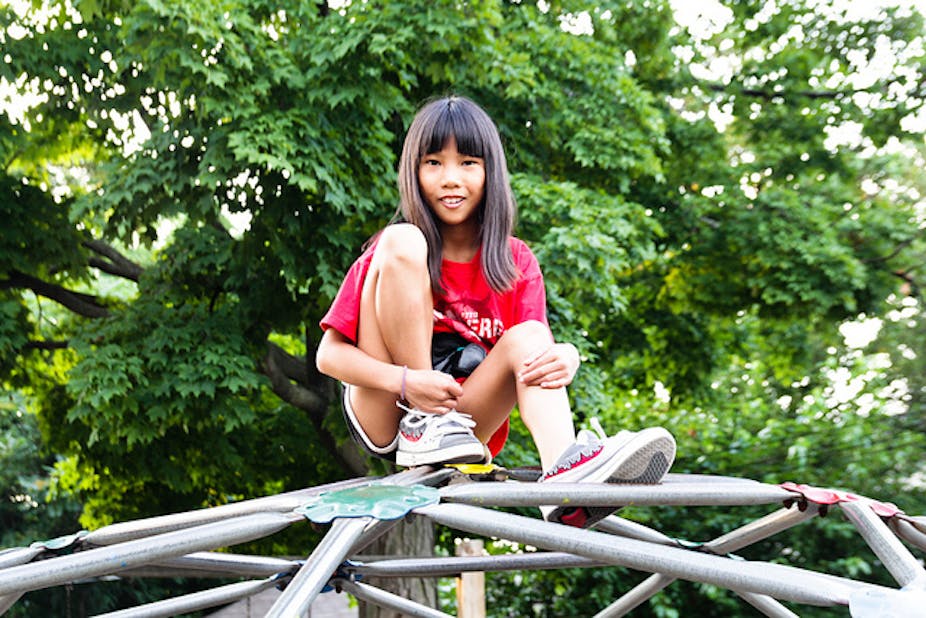The body is a gateway to experiencing and exploring the world. It’s the first thing people see when they look at us and it’s the canvas on which we express who we are. But the relationship we have with our bodies, or our body image, can change over time and is influenced by the messages we receive from our peers, families, society and culture.
One of the most turbulent periods for body image is adolescence. Annual Mission Australia studies of over 45,000 young Australians aged 11 to 24, have consistently found body image to be among the top three concerns of Australian adolescents. Just over one third (34%) of Australian girls report that body image is one their greatest worries, with older adolescents consistently more concerned than their young peers.
If we’re serious about improving girls’ body image, we need to shift the focus from appearance to function and teach girls to value more than just looks.
Why do girls dislike their bodies?
Body dissatisfaction is more common among women than men but this gender discrepancy doesn’t usually become apparent until adolescence.
In childhood, both girls and boys focus on what their bodies can do: jump high, run fast, climb trees. But as bodies develop, girls tend to lose this relationship with their bodies, and their focus moves from function to form. It’s this focus on appearance that results in negative body evaluations.
To understand why girls begin to focus on appearance over functionality, we need only observe the body ideals of Western culture. Males’ ideal body is often associated with functional qualities or characteristics such as muscularity and strength. Females, however, tend to focus on the aesthetic qualities of the body, particularly appearance and weight.
In many Western societies, the female body is sexually objectified and is valued more for its aesthetic appeal. As girls mature physically and psychologically, they begin to internalise the objectified cultural ideals and view their bodies as an object to be evaluated and judged for its beauty and aesthetic appeal. The “female” is viewed less as a person and more as “a body”.
Unfortunately, girls are striving towards an unrealistic and often unobtainable body ideal, leading them to feel dissatisfied with their actual, realistic bodies.

Function rather than form
Research has found that when girls view their bodies through a functional lens, they’re more likely to be satisfied with and appreciate their body. They also report feeling more empowered and physically capable.
The physical activity and sporting environments play an important role in redirecting girls’ focus back to body function. Girls who participate in sports and physical activity express higher value for the functional characteristics of the body and are also more satisfied with not just how their bodies look, but also how they function.
Enrolling girls into sports programs or simply encouraging them to be physically active (walking, hiking, rock climbing) is an effective way to re-introduce them to their functional capabilities and allow them to re-discover the amazing instrument they have within their bodies.
But as children go through adolescence, sports participation in sports activities decreases, with girls participating less than boys. This may be explained by the barriers adolescent girls themselves perceive towards sports participation. Girls report feeling self-conscious or uncomfortable about their bodies, a lack of confidence in their physical abilities and feeling unfeminine as reasons to resist participating in sports.
The sexualisation and overt display of the female body through uniform design can also impact girls’ inclination to participate in specific sports. Track and field, swimming, gymnastics are some examples.
Parents and coaches can play an important role to encourage girls’ participation in physical activity. First, the body needs to be taken off “display” so that judgements aren’t being based upon appearance.
Second, dialogue needs to be directed toward physical competence, enhancing rather than ridiculing girls physical abilities.
Finally, participation does not always have to be structured – unstructured sports play can offer the same opportunities for skill development than structured environments.
Promoting change
The most effective way to combat body image concerns among adolescents is though open dialogue. This allows young people to share any concerns they have about their body and critically evaluate unrealistic messages they receive.
Current programs often focus on educating youth on realistic images of beauty, encouraging them to love their bodies as they are. But although these messages are important, they still put appearance into the spotlight and reinforce the message that appearance is what is most important. The addition of functional body education could have a powerful impact on adolescents’ body perceptions and should be included in such programs.
Overall, parents, coaches and teachers need to acknowledge they have a big impact on how adolescents view their bodies. When discussing the body with young people, highlight the functional aspects rather than the aesthetic ones, and identify the body as a vehicle that has the capacity to offer them some remarkable experiences.

